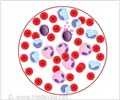Adjuvant chemotherapy with epirubicin and cyclophosphamide for early breast cancer patients increased the risk of Acute myeloid leukemia or Myelodysplastic syndrome.
Recent study published in Journal of clinical oncology reports that early breast cancer patients undergoing chemotherapy with higher than standard cumulative doses of epirubicin and cyclophosphamide have an increased risk of developing Acute myeloid leukemia (AML) or Myelodysplastic syndrome (MDS).This study was done by Dr. David Rogers and his team, in which they have proved that patients undergoing adjuvant therapy with higher than standard cumulative doses of epirubicin and cyclophosphamide for early stage of breast cancer are at increased risk of developing AML or MDS. It has been reported that though the long-term survival of these patients as increased following administration of these drugs, but the risk of developing secondary AML with or without MDS has been increased.
Epirubicin monitoring plan was started by Dr. Rogers collaboration with Gruppo Pfizer of Milan, Italy to undergo 19 randomized clinical trials for adjuvant therapy in early breast cancer, the study included 9796 patients started in early 1984, with follow up till 2001. In this follow-up study 30 patients developed AML/MDS. Both the cumulative doses of epirubicin and cyclophosphamide had independent risk factors for AML/MDS. Other factors such as age, radiotherapy, granulocyte colony stimulating factor and tamoxifen were not independently associated with AML/MDS.
Patients taking more than the standard cumulative dose of epirubicin was found to have an increased relative risk of 6.80. The standard dose of epirubicin was found to be 720 mg/m. For doses no higher than the standard dose, "the low risk of secondary leukemia does not differ significantly from the risk in patients not treated with epirubicin or who received hormonal therapy only," Dr. Rogers' team notes.
Both epirubicin and cyclophosphamide were usually administered in combination and the 4760 patients who received the standard doses of epirubicin and cyclophosphamide (6300 mg/m), the 8-year cumulative probability of developing AML/MDS was 0.37%, compared with 4.97% of the 261 patients who received higher cumulative doses of both drugs.
"In clinical practice, the described regimens have a strong benefit to risk ratio," the authors conclude, "and patients and clinicians can be reassured that the risk of leukemia is likely to be low if the cumulative doses of these regimens are not exceeded."







